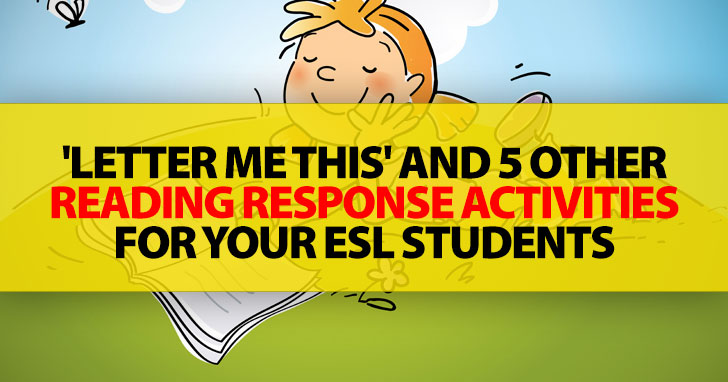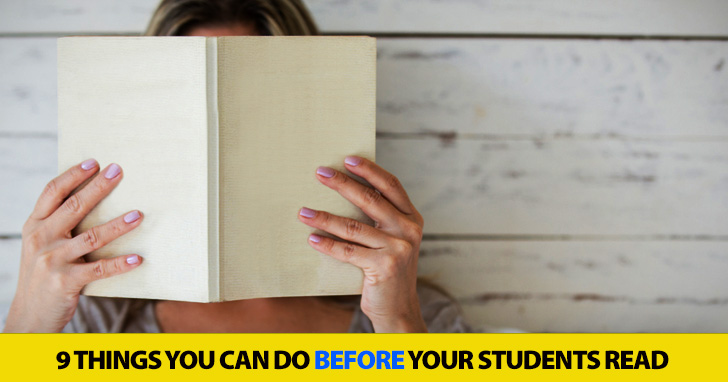'Letter Me This' And 5 Other Reading Response Activities For Your ESL Students


Help them get ready to read that long or longer passage with one of these nine pre-reading strategies. They won’t take a lot of effort on your part, but they will make a huge difference in how well your students understand what they are reading.

A K/W/L chart is one of the most effective and easiest ways to get students ready to read a text. Tell your students what the topic of the reading passage will be. (This works best for nonfiction reading.) Make three columns on your board, and have students make three columns on their papers. Label the first column “know”. Brainstorm with your class everything they already know about the topic of the reading passage. Once students have exhausted their ideas, move on to the second column. Label this column “want to know” and then proceed to list any questions your students have about the topic, things they want to learn from the reading passage. Leave the third column blank until the reading is complete. When you are ready to fill out that column, label it “learned” and have students brainstorm everything they learned from reading the article you assigned.
If your reading passage uses headings or chapter titles, have your students read just the titles and the headings of the passage, and don’t forget the title of the piece. Have them discuss with two or three other students what they think the reading passage will be about and what information they think they will find in it based on the headings.
You don’t have to wait until after your students read a book to show them the movie. Though it may seem anti-intuitive, showing your students the movie of a book they will read can actually help them in the reading process. Because they will have a simple understanding of the plot from the movie, they can concentrate on the specific language they are reading when they go through the pages of the book. That way they can learn more from the language than from the content while they are reading.
Cluster mapping is a good activity to prepare students to read. It is especially useful for helping students see the relationships between ideas. Start by giving your students the topic about which they will be reading. Each person should write that topic in the middle of the page and put a circle around it. Then each person should draw several rays going out from the center circle. At the end of each ray, students should write an idea or item that is related to the topic in the center of the page. Students should circle each of these ideas at the end of the rays. As they are completing their diagram, if they think of ideas or items that are related to the secondary ideas, they should draw rays from the secondary ideas and put those more specific details at the end of those rays. If done correctly, your students should have a connected web of ideas on their paper that all relate back to the original topic of the exercise (and the one about which they will soon be reading).

If your students will be reading a text that includes pictures, diagrams, or other visuals, try this before giving them the text. Make a copy of each of the visuals used in the reading passage. Then give students a chance to look at those visuals and gather whatever information they can from them. They may want to write words on the pictures labeling the different pieces of the pictures, or they may want to read the information in a graph and then write that information out in sentences. Just giving them a chance to look at this visual information and process it, even if it isn’t through the words of the text, will prepare your students for what they are about to read.
If you want to prepare your students for new vocabulary they will encounter in their reading assignment, try this simple activity. First, identify which words you want to preview with them. Then type out the sentences in the reading passage that contain those words. You only need one sentence per word. Give your students a copy of the sentences with the target words underlined. Then have students work with a partner to try and guess the meaning of the target word based on its context in the sentence. Have them write down what they think the words mean before looking them up in an English only dictionary.
If you have been teaching your students root words and their meanings, try this simple exercise. Choose some words in the text that use word roots that your students are either familiar with or that you want them to learn. Give them a list of the word roots and their meanings. Then have students scan the reading passage for words that are based on those word roots, aka your target vocabulary. Your students may very well be able to puzzle out the meaning of the unfamiliar words based on their knowledge of the root at the meaning of its affixes.
Anticipation guides are an interesting way to get your students talking about the material they will read in their reading assignment. An anticipation guide is a simple list of sentences about the topic the reading material covers. Some of the sentences should be true and accurate. Others may not be true, may be opinions, or may be based on common misconceptions. Type out a list of statements (between five and ten is a good number) and give the list to your students. Then have students discuss each sentence in a group of around four students. As they discuss, students should state whether they think each sentence is true or false and why.
A book box is a fun way to introduce a piece of fiction to your students. Start by collecting several items that your students will read about in their reading assignment. For example, if they were going to read Because of Winn Dixie you might have a figuring of a dog, a list of ten items, and a map of a small town. Show your students each of the items and ask them what they think it represents, that is how it will be featured in the book they will read. After you go through all of the items in your box, leave it out in your classroom for students to examine during free learning periods.
Help them get ready to read whatever you assign with one of these (or another) pre-reading strategy. It will make all the difference in how much your students understand the words on the page.